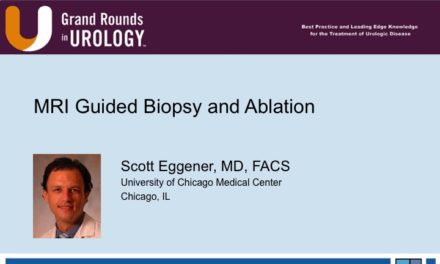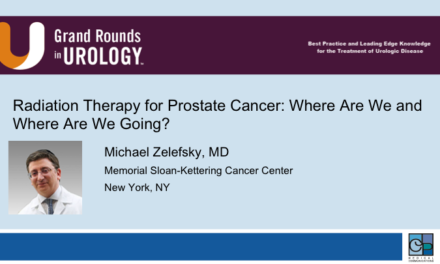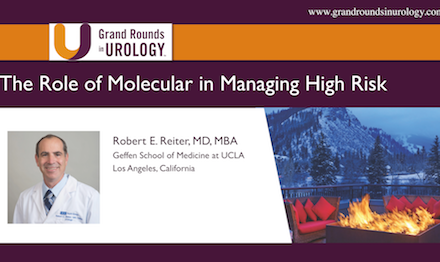Dr. Hirano presented at the 26th International Prostate Cancer Update on Thursday, January 21, 2016, on “Strategies of Radiotherapy for Intermediate to High-Risk Prostate Cancer.”
Keywords: prostrate cancer, androgen deprivation, Estramustine, radiotherapy, PSA
How to cite: Hirano, Daisaku. “Strategies of Radiotherapy for Intermediate- to High-Risk Prostate Cancer.” Grand Rounds in Urology. January 21, 2016. Jan 2025. https://dev.grandroundsinurology.com/prostate-cancer-daisaku-hirano-strategies-of-radiotherapy/.
Transcript
Strategies of Radiotherapy for Intermediate to High-Risk Prostate Cancer
Now I’m talking about strategies of radiotherapy for intermediate to high risk prostate cancer. Especially focus on extra beam radiotherapy. In the former part, maybe it’s a brief review and then I’ll talk about our studies.
How to treat it with radiotherapy for more efficacies in intermediate to high risk prostate cancer? There are several strategies: dose escalation; hypofractionation; prophylactic irradiation to the whole pelvis; in combination with hormone therapy; and also hormone therapy and chemotherapy.
So looking at NCCN guideline, 2015, regardless of life expectancies in intermediate risk. So EBRT with or without brachytherapy here, and with or without androgen depravation therapy for short time and androgen deprivation therapy or LDR brachytherapy alone for low-volume disease. So in high risk and very high risk prostate cancers, extra beam radiotherapy plus androgen deprivation therapy for long term androgen deprivation therapy or EBRT plus brachytherapy with androgen deprivation therapy.
In the EAU guidelines, for intermediate risk the dose, total dose should be 76-78 Gy, in combination with short term androgen deprivation therapy. In high risk, or high risk localized prostate cancer, the total dose is the same dose in combination with long term ADT. In very high risk groups, locally advance prostate cancer, radiotherapy must be given in combination with long term ADT.
Regarding dose escalation, there are many randomized trials that have been reported. Especially biochemical failure survival is benefits but not trial have shown that dose escalation resulted in overall survival benefit.
Regarding hypofractionation, in moderate hypofractionation, in low and intermediate risk it is still unclear whether moderate hypofractionation will ultimately prove to provide similar biochemical control, distant disease survival and cancer specific-survival as standard fractionation.
And looking at extreme hypofractionation, so with 5010 Gy in 4 to 7 fractionations. There are only low risks and selected intermediate-risk patients have been studied. Biochemical control at five years in the low-risk is similar to a high dose IMRT series. However, moderate to high grade acute toxicities ranges 10-20%, it’s very high.
Regarding prophylactic to whole radiation to whole pelvis, so there are many studies have failed to get survival benefit. However, our study, this is o ne of the studies so significant difference in progression-free survival in favor of the whole body irradiation plus neoadjuvant hormone therapy arm over the other treatments in the high risk group.
This is during the androgen deprivation, short term, and intermediate risk group. Look at here, this is the intermediate patients group so androgen deprivation short term androgen deprivation therapy is – – compared with radiotherapy alone. But in the high risk group here, there are no statistical differences.
This is in the high risk group, this is one of the key studies is regarding the long term androgen deprivation therapy with radiotherapy. The combination of radiotherapy plus long terms androgen deprivation therapy provides superior survival.
This is a key article. Looking at androgen or chemotherapy plus androgen deprivation therapy concomitant with radiotherapies so after availability of use of docetaxel some randomized, some trials, studies undergoing but this is one of the studies from a French group. These are two arms, one androgen deprivation therapy plus docetaxel and estramustine group. The other arm is only androgen deprivation therapy. And neoadjuvant three months and local treatment including the most 80, 90%, almost 90% including the radiotherapy.
This study is still, they had no survival data, so only PSA response data. PSA value at three months, less than 0.5 ng/ml before local treatment. Androgen deprivation plus docetaxel and estramustine is superior so more PSA so lower.
But regarding the toxicities, neutropenia grade 3 and 4 is almost 50% so severe hematological toxicities often.
Now move to our study regarding the neoadjuvant LHRH analog plus estramustine phosphate is combined with three-dimensional CR for intermediate to high risk prostate cancer. This is a randomized study, but very small numbers of patients.
Look at the mechanisms of action in estramustine. Estramustine is a very, not so expensive, very cheap and oral agent. Estramustine has both mechanisms, one is hormonal action and the other is cytotoxic action. Here, so cytotoxic action target is the microtubule.
This is more magnified the structure of microtubules. Estramustine binds microtubules associated proteins and alpha tubulin, and beta tubulin at a site near, but not overlapping the taxane site. Taxanes bind, such as docetaxel, bind beta tubulin at sites distinct from estramustine binding.
Why is estramustine in combination with radiotherapy benefit for the treatment of prostate cancer? Cell kinetic studies have shown that estramustine causes G2-phase arrest. Cells are most radiosensitive in the G2/M phase. Estramustine enhances radiation-induced cytotoxicity in DU-145 cells in culture and also in transplanted into nude mice. Therefore, estramustine is considered to have radiosensitizing properties.
This is a study population chart. Only 41 patients recruited, and 40 patients randomized to the estramustine arm 20 patients and LHRH agonist plus estramustine 560 mg per day. The other arm, the LHRH arm is 20 patients, the same number, but one patient withdrew. Six neoadjuvant therapy and 20 patients, so also 3D-CRT, patients received 70 Gy, both same. And median duration of follow-up of 98 months. Very recently, so I checked the data, so six patients had PSA failure, two patients developed distant metastasis and one patient cancer-specific died, here is estramustine arm. This is the LHRH arm, also four patients, 10 patients had PSA failure, four patients developed distant metastasis and two patients cancer-specific died.
This is patient characteristics. Estramustine arms, and this is interim analysis so median PSA nadir after treatment and also median time from initial treatment to PSA nadir, so estramustine group, it’s very low. Both numbers are low.
Looking at biochemical recurrence-free survival, but this is a published paper interim analysis, so there are differences, – – difference, estramustine group is a very nice curve.
Correlation between PSA relapse and variables by Cox proportional hazards regression analysis, so in univariate analysis, pretreatment PSA tumor grade, modality of estramustine group versus LHRH group is there. Independent factors for the cancer, PSA relapse overall survival.
For long follow-up there both groups is distant metastasis-free survival and also cancer-specific survival, in both group there are no statistical difference.
But looking at the adverse events, this is, estramustine is not so severe adverse effects, no cardiac event.
In conclusion the combination therapy of neoadjuvant androgen deprivation therapy and estramustine and concomitant with radiotherapy, 70 Gy, sustains freedom from PSA relapse in intermediate to high risk prostate cancer in the interim period. However, it is insufficient in preventing distant metastasis and cancer-specific mortality at the long follow-up duration. Therefore, additional interventions, dose escalation so current standard dose of 76-78 Gy. Adjuvant androgen deprivation therapy, in high risk, or intermediate risk group, there is at least short duration, and in the high risk group so long androgen deprivation therapy. And also need a study involving a large number of patients.
This is a summary so intermediate risk, EBRT with short androgen deprivation therapy is a standard radiotherapy. In high risk, EBRT is with long term androgen deprivation therapy is a standard radiotherapy. The use of a combined modality approach, consisting of dose-escalation, irradiation to the pelvic lymph nodes in especially locally advanced cases may be efficient. Studies on combined with chemotherapy using docetaxel plus estramustine and androgen deprivation therapy are under way. Neoadjuvant with estramustine plus androgen deprivation therapy and concurrent with current standard dose EBRT plus adjuvant long-term androgen deprivation therapy may be more efficient for preventing cancer.
ABOUT THE AUTHOR
Dr. Hirano is Vice President of Urology at Higashimatsuyama Municipal Hospital in Higashimatsuyama, Saitama Province, Japan. He has served as an Associate Professor in the Department of Medicine at Nihon University in Tokyo, Japan. He also received his medical degree from Nihon University. He has published widely on various urological subjects, including androgen deprivation therapy, upper urinary tract urothelial carcinoma, and imaging for prostate cancer.





